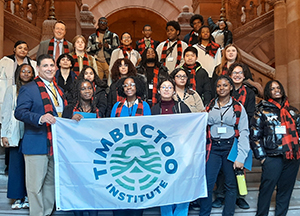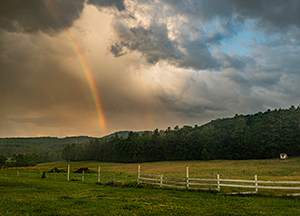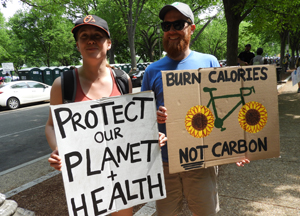
Adirondack Council Introduces International Coalition to Adirondack Conservation
Wednesday, October 7, 2015
By: John F. Sheehan - Adirondack Council Communications Director
On September 8, two Adirondack Council colleagues and I had a chance to meet with an international coalition of 10 conservationists from all corners of the globe to discuss the unique nature of the Adirondack Park and how it is a model for the protection of lived-in natural areas around the world.
Creating and protecting parks is what the United States has been doing well for more than a century. The Adirondack Park is one of the oldest and finest examples.
Every couple of years the U.S. State Department asks the International Center for the Capital Region (IACCR) to host conservationists who want to see New York’s great parks system, as well as its wilderness parks in the Adirondacks and Catskills. For more than a decade, the Adirondack Council has worked with the IACCR to teach visiting conservationists why the Adirondack Park is America’s greatest park and a true international treasure. The two most recent delegations were from Japan and South America. This group was from everywhere.
Conservation Director Rocci Aguirre and I were joined by our Eugene and Emily Grant Fellow Marin George at the Adirondack Park Agency’s conference room, where we met with conservationists from Afghanistan, Belize, China, Guyana, Jordan, Liberia, South
Africa, Tanzania, and Turkey. They were led by two State Department representatives and they had already spent two weeks touring national parks to better understand how we promote tourism and conservation in large federal preserves where no one lives.
While they had enjoyed their visits to national parks out West, they said they were especially excited to learn about the Adirondack Park. All of them were attempting to protect large natural areas that had people living inside of them. Back home, like here, they had to find a way to incorporate conservation into a landscape with permanent communities, homes and businesses.
They had already seen the Wild Center in Tupper Lake and Paul Smith’s College before out meeting, so they had heard about our constitutionally protected Forest Preserve and seen the abundance of pure water coursing through the Park.
We explained the part-public/part-private nature of the Adirondack Park’s landscape and told them how that mix helps the Park to maintain a high level of biological diversity.
Rocci described his job, which requires knowledge of the Park’s ecology and the ability to work with state government officials as they establish and modify state policies to better protect nature. At the same time, he works with local government officials to establish new outdoor recreation opportunities and better access to public trails and waters near communities for visitors and residents.

Adirondack Park Agency Director of Communications
Keith McKeever and Wildlife Conservation Society
Scientist Heidi Kretser
We were joined by Keith McKeever, Director of Communications for the Adirondack Park Agency, and by Wildlife Conservation Society (WCS) Adirondack Director Zoe Smith and WCS scientist Heidi Kretser. They talked about “Conservation Design,” or channeling development into appropriate places, while preventing development in locations where it would harm water quality and native wildlife.
Together, we communicated what has worked in the Adirondack Park since it was created in 1892, where we have had challenges, and explained how those successes and lessons learned could be transplanted elsewhere.
Our job was made considerably easier – and we were humbled a bit -- by the fact that all 10 representatives in the coalition spoke perfect English.
In many ways, we have similar problems to solve. How do we best balance conservation with active forest management, wildlife stewardship with economic development, or people’s homes with efforts to protect clean water? These dilemmas seem to be universal. We can learn much from each other’s experiences.
Some were stunned by the size of the Adirondack Park. Josue Ramos of Belize noted that his entire nation would fit inside the Adirondack Park, with some room left over. We informed him that any four of the national parks he had just seen out west would fit inside the Adirondack Park also.
Other issues did not translate as well.
For example, Nomothamsanqa Nyembe is the Community Conservation Officer for the Ezemvelo KwaZulu Natal Wildlife Park in South Africa. Nine months ago, two of the park’s rangers killed a poacher who was illegally hunting endangered rhinoceroses, and who she said fired at them when they confronted him. Local police arrested the rangers. She also spoke of having to compensate farmers when wildlife from the preserve strayed outside of its unfenced boundaries and killed farm livestock.
Not all concerns were matters of life and death, however.
Zhanfeng Liu, Associate Professor at the South China Botanical Garden, Chinese Academy of Sciences, had many questions about concealing modern amenities such as cell towers and amusements amid natural features and took many notes regarding the Adirondack Park Agency’s “substantially invisible” policy for new telecommunications towers.

Adirondack Council Conservation Director Rocci Aquirre
talks with Othman Al Tawalbeh of Jordan In fact, Zhanfeng chuckled and poked Othman Al Tawalbeh of Jordan in the ribs after seeing a “thumbs down” in our State of the Park Report for 2014 for a zip-line amusement near the Village of Lake George. Othman, whose business card read Friends of the Earth, Middle East, had just completed a zip-line amusement ride in his new eco-park in Jordan.
We quickly explained that we were not opposed to zip lines. We had supported one in another area of this same lake basin. However, this project a would be visible from the main interstate highway entrance to the Adirondack Park (I-87, the Northway). So, it threatened to degrade the scenic beauty upon which all local businesses depend, we explained.

Adirondack Director of Wildlife Conservation Society Zoe Smith
and Rocci Aguirre talk with Arpakwa Sikorei of TanzaniaArpakwa Sikorei is the Project Assistant for UNESCO at the World Heritage Site Ngorongoro Conservation Area. He was pleased to see places so different from the arid grasslands of his home. He wore a traditional Maasai wrist band, and a red-and-white I Love NY lapel button. But it was his two shirts, jacket and scarf that seemed out of place. It was over 82 degrees and humid in Ray Brook. I had sweated through my shirt while speaking to the group at 9 a.m. Now it was near noon and poor Arpakwa was still freezing.
Most of the coalition was envious of the Adirondack Park’s accessibility, with well-paved roads, communications lines and power lines connecting its communities, as well as thousands of miles of trails already in place and dozens of places where people with disabilities could experience wilderness.
Perhaps the most thought-provoking and universal issue we discussed was the Wildlife Conservation Society’s newest research in the Adirondack Park and Yellowstone National Park about the impact of low-density (suburban and rural) development. WCS’s studies show that the addition of a single one-acre home site in a pristine forest chases away wilderness birds and others sensitive species across an area of roughly 30 acres. If those homes are grouped in a compact pattern, rather than spread across the entire parcel, most of the rarest wildlife habitat can be preserved, noted Zoe and Heidi from WCS.
After our meeting, the coalition took a ride up Whiteface Mountain to see the castle on the summit and learn about Bicknell’s Thrush, a rare neo-tropical songbird that breeds on the Adirondack Forest Preserve, not far from the roadway. Then it was back to Albany and the trip home. We hope they had a great time while they were here and brought a little piece of Adirondack conservation back home with them.
|
Would you like to comment on what you've read or viewed? We'd love to hear from you. Please click to send us a message.
Born and raised in Troy, NY, John Sheehan is a graduate of Catholic Central High School and the State University at Albany (1985; BA). Before joining the Council's staff in 1990, John was the managing editor of the Malone Evening Telegram, just north of the Adirondack Park. Prior to that, he worked as journalist for the Troy Record, (Schenectady) Daily Gazette, Watertown Daily Times and Newsday. John is a regular guest lecturer at several New York colleges and universities, including Colgate University, Hobart & William Smith College, Hamilton College, Rensselaer Polytechnic Institute, Union College, Siena College, SUNY Albany, SUNY Binghamton, SUNY College of Environmental Science and Forestry (Syracuse), and SUNY Potsdam. He has also addressed dozens of local organizations including local Rotary and Kiwanis clubs and chambers of commerce, scientific societies and community forums. John and his wife Deborah live in Albany and are seasonal residents of the Adirondack Park. Their daughter Hannah attends Albany public schools. |
||





